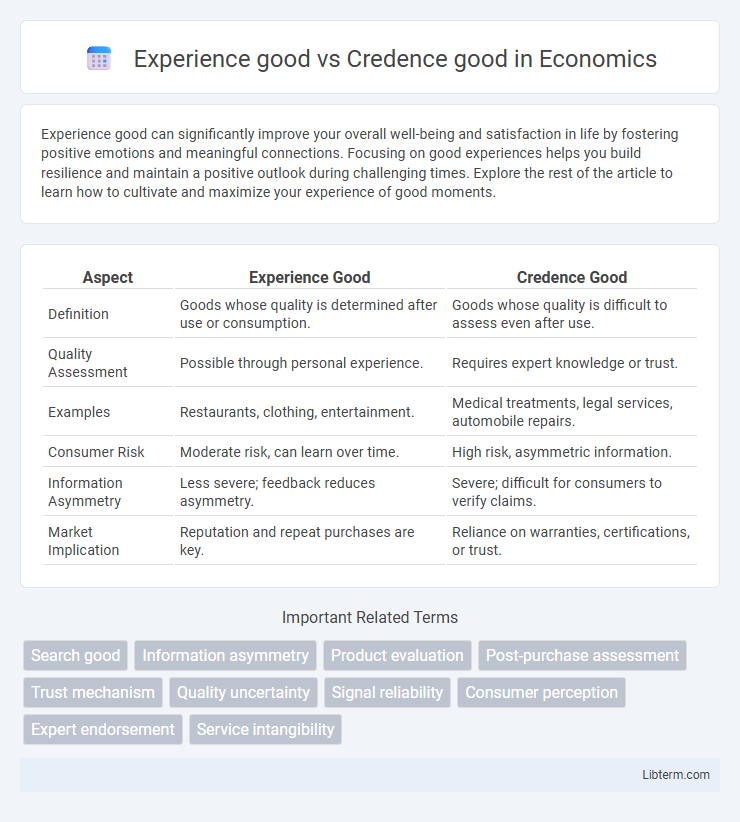Experience good can significantly improve your overall well-being and satisfaction in life by fostering positive emotions and meaningful connections. Focusing on good experiences helps you build resilience and maintain a positive outlook during challenging times. Explore the rest of the article to learn how to cultivate and maximize your experience of good moments.
Table of Comparison
| Aspect | Experience Good | Credence Good |
|---|---|---|
| Definition | Goods whose quality is determined after use or consumption. | Goods whose quality is difficult to assess even after use. |
| Quality Assessment | Possible through personal experience. | Requires expert knowledge or trust. |
| Examples | Restaurants, clothing, entertainment. | Medical treatments, legal services, automobile repairs. |
| Consumer Risk | Moderate risk, can learn over time. | High risk, asymmetric information. |
| Information Asymmetry | Less severe; feedback reduces asymmetry. | Severe; difficult for consumers to verify claims. |
| Market Implication | Reputation and repeat purchases are key. | Reliance on warranties, certifications, or trust. |
Introduction: Defining Experience Goods and Credence Goods
Experience goods are products or services whose quality can only be accurately assessed after purchase and use, such as restaurants or software. Credence goods, by contrast, are items whose quality or necessity is difficult for consumers to evaluate even post-consumption, including medical treatments or car repairs. Understanding the distinction between experience goods and credence goods is crucial for marketers and consumers to navigate uncertainty and build trust in transactions.
Key Differences Between Experience Goods and Credence Goods
Experience goods allow consumers to assess quality only after purchase and use, such as restaurants or smartphones, while credence goods possess attributes difficult or impossible to evaluate even post-consumption, including medical treatments or legal services. Experience goods rely heavily on consumer reviews and trial opportunities to reduce uncertainty, whereas credence goods depend on trust, expert qualifications, and reputation due to asymmetrical information. The key difference lies in the evaluation timing and difficulty: experience goods can be judged through personal use, but credence goods require consumers to depend on external validation.
Consumer Decision-Making: Experience vs. Credence Goods
Experience goods enable consumers to evaluate product quality through direct use, leading to informed decision-making based on personal satisfaction and sensory feedback. In contrast, credence goods pose challenges in assessment even after consumption, requiring trust in expert opinions, brand reputation, or external certifications to guide purchasing decisions. Consumer behavior diverges accordingly, with experience goods fostering trial and review reliance, while credence goods demand reliance on signals of credibility to mitigate uncertainty.
Role of Information Asymmetry in Experience and Credence Goods
Experience goods are products whose quality can be evaluated after consumption, reducing information asymmetry as consumers gain firsthand knowledge. Credence goods, in contrast, have qualities that remain difficult to verify even post-purchase, maintaining high information asymmetry and reliance on expert knowledge or trust. The persistent information gap in credence goods leads to market inefficiencies, increasing the importance of warranties, certifications, and reputation as signals to mitigate uncertainty.
Examples of Experience Goods in the Marketplace
Experience goods, such as restaurants, movies, and smartphones, require consumers to use or experience the product before fully assessing its quality, as their value cannot be accurately determined through pre-purchase information alone. In the marketplace, consumers often rely on personal use, reviews, or word-of-mouth to evaluate the satisfaction and reliability of products like streaming services, apparel brands, and automobiles. These examples highlight how experience goods depend on trial and consumer feedback to establish trust and perceived benefit, differentiating them from credence goods where quality remains uncertain even after consumption.
Common Credence Goods and Their Characteristics
Common credence goods include medical treatments, legal services, and automotive repairs, characterized by consumers' inability to accurately assess quality even after consumption. These goods rely heavily on trust and expert reputation due to asymmetric information between provider and consumer. Characteristics of credence goods involve difficulty in evaluation, dependence on professional advice, and potential for supplier opportunism.
Quality Assurance Challenges for Experience and Credence Goods
Experience goods require quality assurance processes centered on user feedback and performance evaluation since their true quality is revealed post-purchase. Credence goods pose greater quality assurance challenges as consumers cannot easily assess product quality even after use, relying heavily on certifications, expert endorsements, and regulatory compliance. Ensuring trustworthiness and maintaining transparent quality standards are critical to overcoming information asymmetry in credence goods markets.
Impact of Branding and Reputation on Consumer Trust
Experience goods allow consumers to evaluate quality after purchase, making branding a key factor in establishing trust through consistent performance and reputation. Credence goods, which are difficult to assess even post-purchase, rely heavily on strong branding and reputable endorsements to assure consumers of their value and reliability. Effective branding builds consumer confidence by signaling quality, reducing perceived risk, and enhancing trust in both experience and credence goods.
Marketing Strategies for Experience and Credence Goods
Marketing strategies for experience goods emphasize product trials, customer reviews, and sensory appeals to allow consumers to evaluate quality post-purchase, leveraging advertising and promotions that highlight direct benefits and user satisfaction. Credence goods require marketing approaches that build trust and credibility through expert endorsements, certifications, and transparent information because consumers cannot easily verify product quality even after consumption. Brands often invest in educational content, warranties, and strong after-sales service to reduce perceived risk and reinforce confidence in credence goods.
Conclusion: Navigating the Experience–Credence Good Spectrum
Experience goods require direct user interaction to assess quality, making consumer feedback critical, while credence goods demand trust in expert claims due to their unverifiable attributes. Businesses must tailor marketing strategies by emphasizing transparent information and credible endorsements to build confidence across this spectrum. Successfully navigating between experience and credence goods enhances consumer satisfaction and drives informed purchasing decisions.
Experience good Infographic

 libterm.com
libterm.com